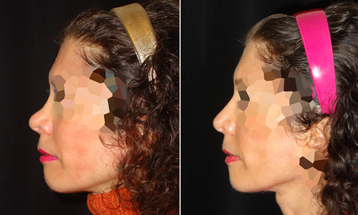
Rhinoplasty for saddle nose
According to the various degrees of depression you can have different surgical choices that in most cases require the use of grafts. In the cases in which the dorsal depression is slight or moderate it can be sufficient to use "onlay" grafts, that is, simply placed and affixed to the residual structures of the dorsum in order to fill the depression zone. Septal or auricular flattened or morcellised cartilage is used.
The more serious cases of saddle nose need not only an aesthetic approach, but also more importantly, functional restoration. If the internal nasal valve is also involved it is necessary to restore function through spreader grafts or other techniques. Often the support to the tip is compromised and will have to be reconstructed. Cases involving the use of rib cartilage give, in the Author's experience, the best results. Rib cartilage serves to construct a new structure in the shape of an "L" destined to replace the missing supporting structures of the nose: the septum, the nasal roof and the tip.

Saddle nose resulting from inappropriate septal surgery. Reconstruction with rib cartilage. Open rhinoplasty
The saddle nose
Saddle nose is a deformity consisting of a excessive external lowering of the nasal dorsum that provokes not only aesthetic issues but also, quite often, respiration problems. In fact saddle nose often accompanies other problems such as stenosis of the inner nasal valve, loss of support to the tip, retraction of the columella.
The causes of saddle nose
Even though the deformity of saddle nose can be congenital, in the overwhelming majority of the cases it is acquired as a consequence of several possible causes, namely:
- a facial trauma
- a surgical procedure
- cocaine use
- some rare diseases (Wegener's granuloma, leprosy, autoimmune diseases…)
Saddle nose as a result of trauma
A direct trauma to the nose can cause a fracture with crushing of the nasal bones: it doesn't just occur during violent accident, but often happens to athletes who practice sports with physical contact. Naturally boxing is high on the list, but also soccer, basketball, water volleyball and all sports in which accidental elbows in the face are not unusual. Since mainly male athletes play these sports, it is not surprising that saddle nose trauma is more diffuse in males.
Furthermore an internal septal hematoma can occur after trauma to the nose. If this is not diagnosed it can be become infected causing an irreversible necrosis of the cartilage with consequent loss of support and "collapse" of the nasal bridge
Saddle nose as a result of rhinoplasty
After excessive removal of the nasal hump during rhinoplasty the profile of the nose can take on a concave appearance over time that besides, if excessive, being unpleasant to look at, constitutes the classic undesired post-rhinoplastic look.
A nasal tip that is too long can also give the impression of a saddle nose: in this case the expert rhinoplastic surgeon, when planning the surgery, will have to carefully study the profile of the patient in order to find the correct equilibrium between the removal of the hump and the shaping of the tip.
Grafts for saddle nose
AUTOLOGOUS GRAFTS constitute material retrieved from the same patient and therefore their biocompatibility is absolute. Septum cartilage is the ideal choice, but is not always available in the amount required. We are dealing in fact with noses already operated on or those that naturally lack nasal septum and consequently have a low nasal bridge. You must resort to the cartilage of the ear in the instance of insufficient septum cartilage. The removal is through a small incision hidden behind the ear. The shape of the auricular pavilion does not change in any way.
For more complex reconstructions you must resort to rib cartilage that offers the characteristics of structural resistance that is necessary to correct more serious deformities.
HOMOLOGOUS GRAFTS are tissues taken from donors and suitably treated (they are subjected to radiation) to acquire biocompatibility.
ALLOPLASTIC SYNTHETIC GRAFTS exist in numerous forms. The most diffuse and reliable are: Polyamide mesh (Mersilene), Polytetrafluoroethylene ePTFE (Gore-Tex), high density porous Polyethylene (Medpor). Gore-Tex integrates very well with the surrounding tissues, and, in selected cases, is used by the Author.
THE CHARACTERISTICS OF THE IDEAL GRAFT
it is not carcinogenic
it does not provoke inflammatory reaction
it is not reabsorbed
it is easily shaped
it has a similar consistency to the tissue to be reconstructed (cartilage)
it does not tend to be rejected
it integrates with the surrounding tissues

Post trauma saddle nose of medium extent in an athlete (martial arts). Onlay technique, open rhinoplasty.

Post trauma saddle nose of medium extent. Correction carried out with septum cartilage. Onlay technique, secondary open rhinoplasty.

Saddle nose as result of surgery. Reconstruction with septal cartilage. Open rhinoplasty.

Saddle nose as result of multiple surgeries. Reconstruction with rib cartilage. Open rhinoplasty.